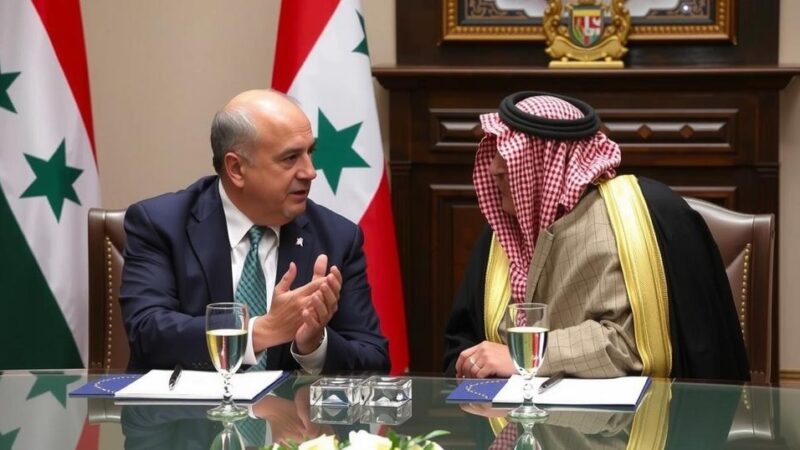Iran’s President Masoud Pezeshkian is visiting Qatar to strengthen diplomatic ties while Iranian ground forces conduct joint military training with Oman. This visit coincides with heightened Iranian efforts to solidify partnerships amid ongoing conflicts and regional tensions, particularly against Israel. Pezeshkian’s participation in the ACD summit and the military collaboration with Oman illustrate Iran’s strategies to enhance its influence in the region.
Iran’s President Masoud Pezeshkian is embarking on a diplomatic visit to Qatar, as reported by Iranian state media. This trip follows his recent attendance at the UN General Assembly in New York and his meeting with Russia’s Prime Minister earlier this week. The president’s active engagement in international diplomacy underscores Iran’s efforts to strengthen its diplomatic relationships amid ongoing conflicts involving its regional proxies, particularly against Israel. Pezeshkian is scheduled to meet the Emir of Qatar, Sheikh Tamim bin Hamad bin Khalifa Al Thani, and participate in the 19th Asian Cooperation Dialogue (ACD) Summit in Doha. This two-day visit, conducted at the Emir’s official invitation, will also feature high-ranking delegations from Iran and Qatar and the signing of various cooperation agreements. It is worth noting that Qatar has been a host to Hamas leaders and has openly criticized Israel at international forums, especially following recent military actions involving Hezbollah. The expectation for Doha to mediate a ceasefire deal between Hamas and Israel, however, appears increasingly tenuous, signaling a shift in Qatar’s role from a potential peacemaker to a more confrontational stance against Israel. Furthermore, President Pezeshkian’s participation in the ACD, a forum aiming to foster cooperation among Asian nations since its inception in 2002, reflects Iran’s ongoing diplomatic outreach. In parallel, Iran’s relationships within other economic associations like BRICS and the Shanghai Cooperation Organization (SCO) indicate its strategic alignment with powers like China and Russia. Concurrently, Iranian state media announced that Iranian ground forces have initiated joint military training exercises with Oman, named Mountain Falcons 1 (Saqour al-Jabal 1), which commenced this week in Oman’s Jebel Al-Khader province. This exercise includes not only the Iranian Army’s ground forces but also the Sultanate’s Army and is aimed at enhancing combat readiness and operational capabilities. This development signals a strengthening of Iran-Oman relations, notwithstanding Oman’s traditionally neutral stance in Middle Eastern diplomatic conflicts. Oman has positioned itself as a relatively stable nation amidst regional tensions, having refrained from joining the Gulf states in severing ties with Qatar during the Gulf crisis and maintaining relations with various countries along the Indian Ocean. The increasing collaboration between Oman and Iranian forces may raise concerns regarding Iran’s influence in a region marked by geopolitical complexities. It is important to clarify that the involved Iranian forces differ from the ideologically-driven Islamic Revolutionary Guard Corps, indicating a more conventional focus on cooperation and stability rather than outright aggression. Iran’s strategic maneuvers in both diplomatic and military arenas highlight its ambitions to project power and influence throughout the Gulf region, even as its actions may provoke mixed reactions from neighboring states.
The article focuses on Iranian President Masoud Pezeshkian’s diplomatic strategies and military collaborations, particularly with Qatar and Oman. This engagement occurs against a backdrop of escalating tensions in the Middle East, particularly involving Iran’s proxy conflicts with Israel. The significance of these interactions lies in Iran’s quest for stronger alliances in the region while also dealing with its expanding military capabilities through joint exercises with Oman. The context of these developments includes Qatar’s role in regional dynamics, especially regarding its relationship with Hamas, and the implications of Iran’s military initiatives in securing its interests amidst ongoing conflicts.
In summary, President Pezeshkian’s visit to Qatar and the joint military exercises with Oman underline Iran’s proactive approach to enhance its diplomatic ties and military readiness in the Gulf region. These developments reflect Iran’s desire to strengthen its influence while navigating a complex geopolitical landscape characterized by rivalries and shifting alliances. As Iran continues to forge stronger partnerships, the broader implications of these actions on regional stability and security remain to be seen.
Original Source: www.jpost.com







